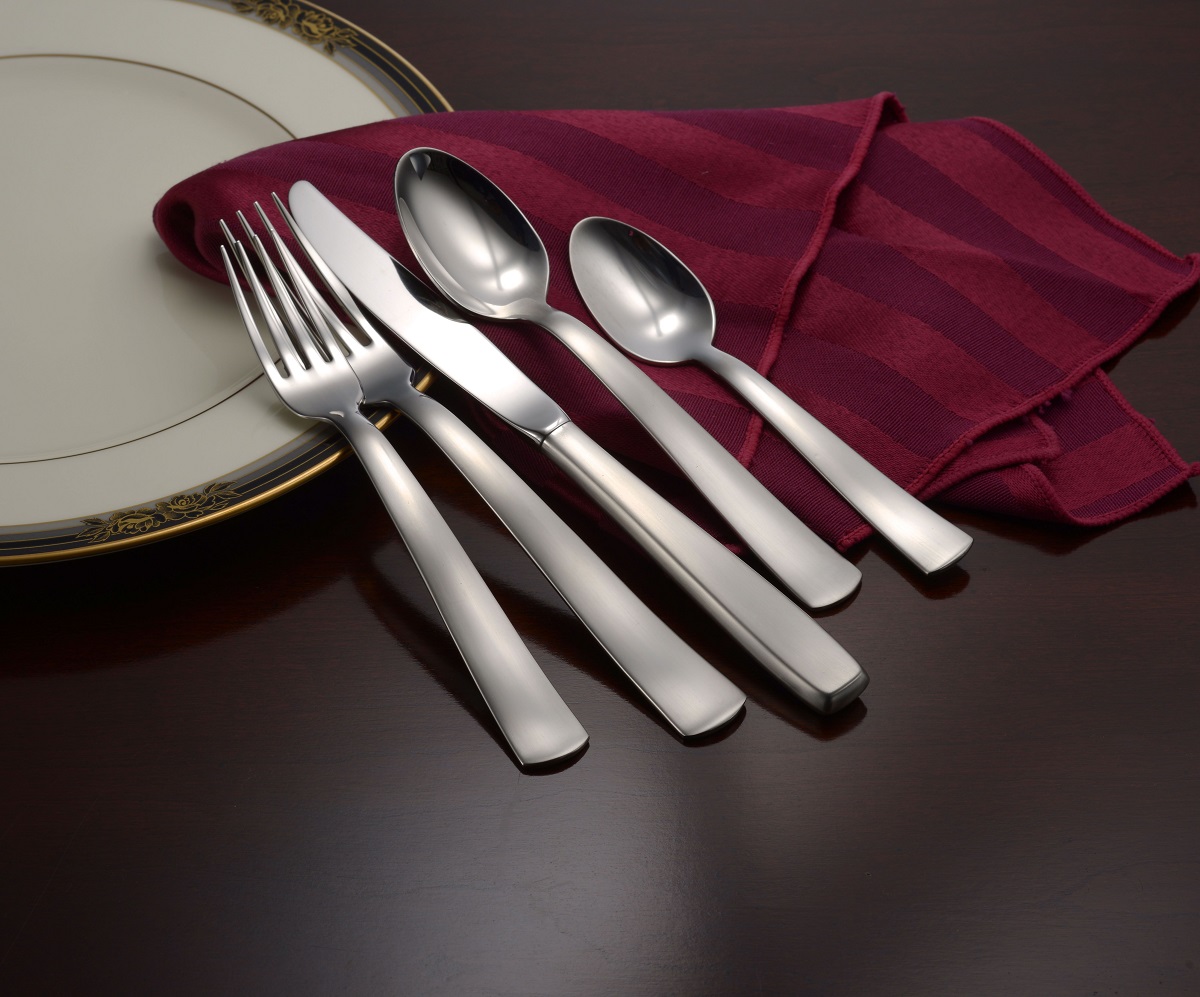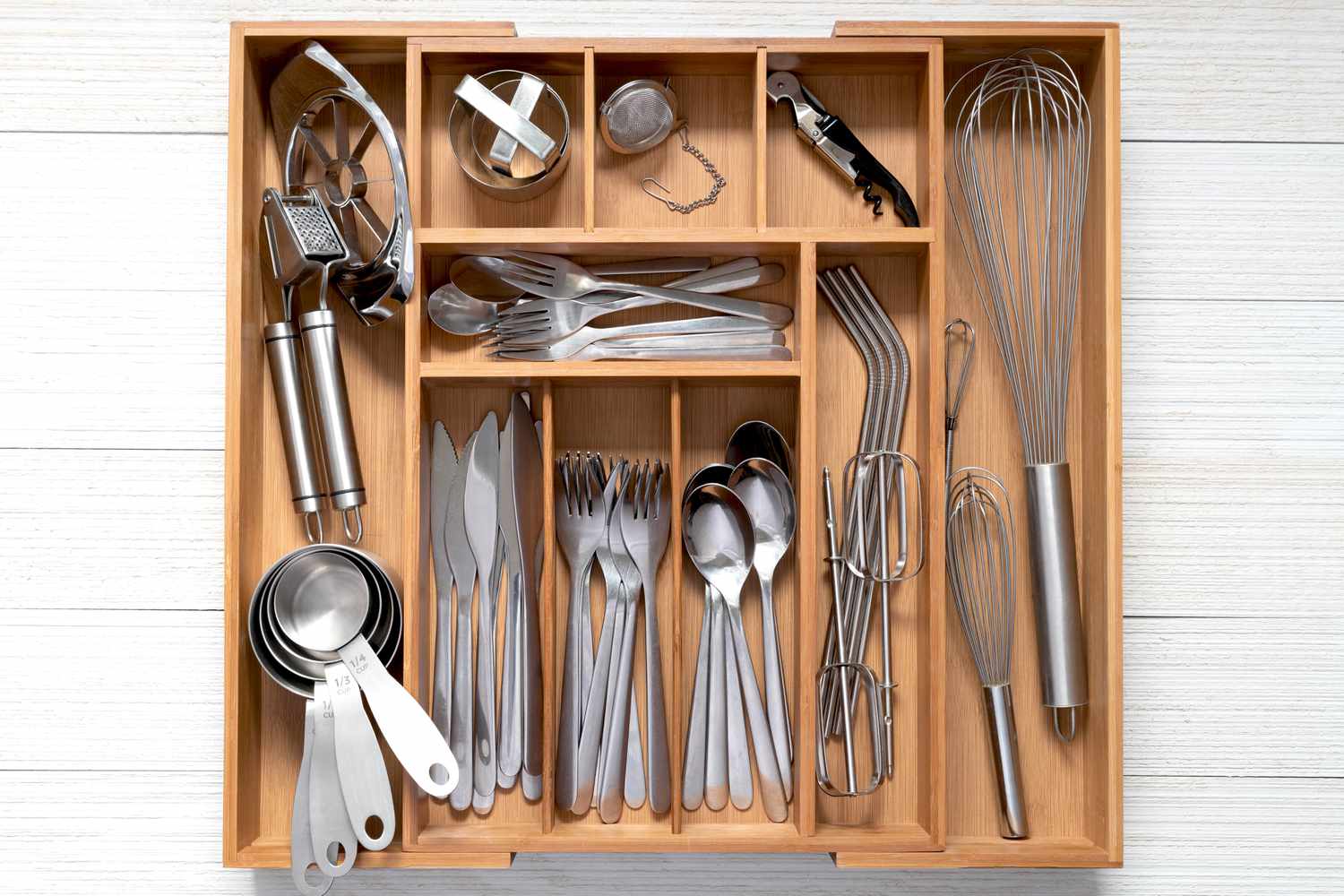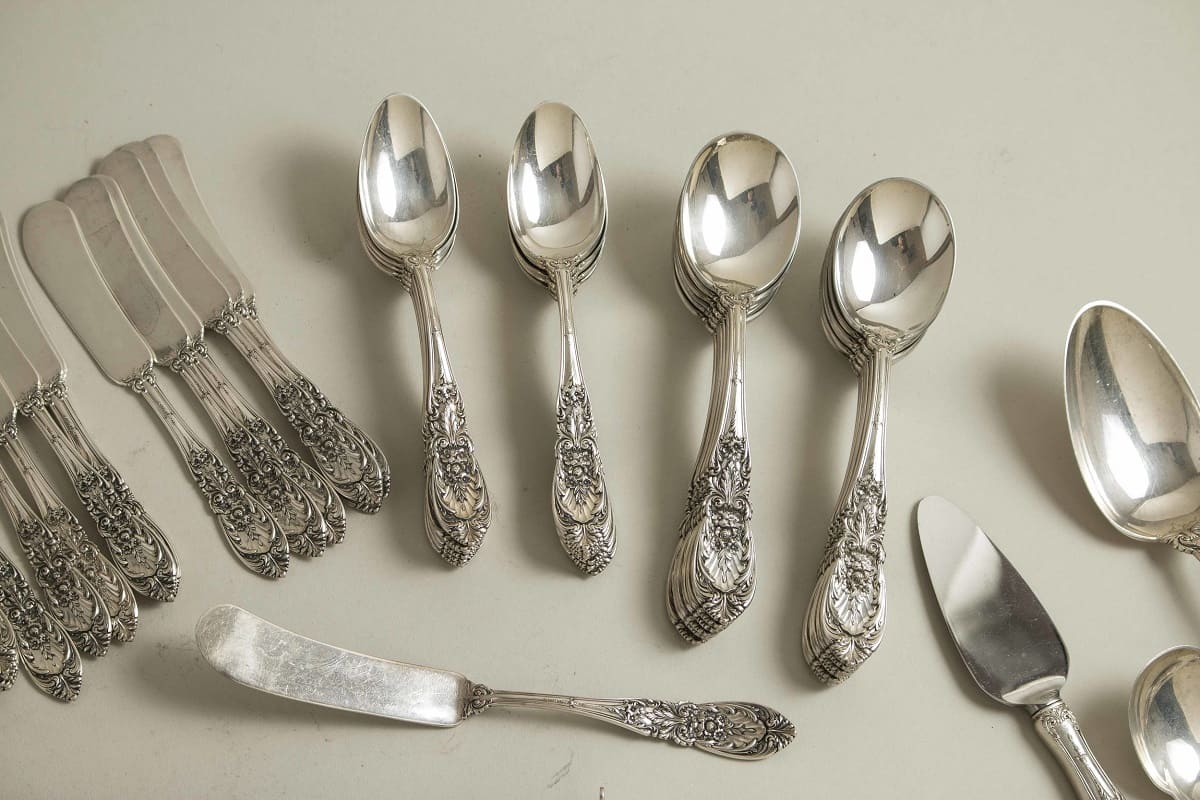Home>Kitchen & Cooking>Kitchen Gadgets & Utensils>What Is Flatware?


Kitchen Gadgets & Utensils
What Is Flatware?
Modified: October 20, 2024
Discover the essential kitchen gadgets and utensils with our guide to flatware. Learn about the different types and uses of flatware for your cooking and dining needs.
(Many of the links in this article redirect to a specific reviewed product. Your purchase of these products through affiliate links helps to generate commission for Storables.com, at no extra cost. Learn more)
Introduction
When it comes to equipping a kitchen with the essential tools for dining, flatware is an indispensable component. Whether you're setting the table for a casual family dinner or an elegant dinner party, the right flatware can elevate the dining experience. From the gleam of polished stainless steel to the timeless elegance of silver, flatware encompasses a wide array of styles and materials, each with its own unique charm.
As we delve into the world of flatware, we'll explore the various types and materials used, as well as provide insights on how to choose the perfect set for your needs. Additionally, we'll discuss the importance of proper care to ensure that your flatware maintains its luster and functionality for years to come.
So, let's embark on a journey through the fascinating realm of flatware, where functionality meets artistry, and where the right utensils can transform a meal into a delightful culinary experience.
Key Takeaways:
- Flatware, also known as silverware or cutlery, encompasses a range of utensils like forks, knives, and spoons. It’s not just for eating, but also adds style and elegance to dining experiences.
- When choosing flatware, consider style, comfort, durability, and versatility. Proper care, like regular cleaning and storage, helps maintain the beauty and functionality of flatware for years to come.
Read more: What Is Silver-Plated Flatware
Definition of Flatware
Flatware, also known as silverware or cutlery, refers to the utensils used for eating and serving food. It encompasses a range of tools, including forks, knives, spoons, and serving utensils, that are essential for dining and food preparation. Flatware is a fundamental part of table settings, playing a crucial role in the overall dining experience.
In a broader sense, flatware extends beyond mere functionality and serves as an expression of style and elegance. The design and craftsmanship of flatware can enhance the visual appeal of a table setting, adding a touch of sophistication to any meal. From sleek and modern designs to ornate and traditional patterns, flatware reflects diverse cultural influences and personal preferences.
The term "flatware" is derived from the flat, thin nature of these utensils, distinguishing them from hollowware, which includes items such as bowls, platters, and teapots. Flatware is often made from durable materials such as stainless steel, silver, or gold, and its composition can significantly impact its appearance, weight, and maintenance requirements.
In essence, flatware serves as both functional tools for eating and serving food and as decorative elements that contribute to the aesthetic appeal of a dining experience. The versatility and significance of flatware make it an essential aspect of culinary culture and an integral part of everyday life.
Types of Flatware
Flatware encompasses a diverse range of utensils, each designed for specific dining purposes. Understanding the various types of flatware is essential for creating well-coordinated table settings and ensuring that the right utensil is used for each course. Here are the primary types of flatware commonly found in dining collections:
-
Dinner Fork: The dinner fork is a staple of flatware sets, featuring a slightly larger size and sturdy tines to accommodate main course dishes. Its design is tailored to handle heartier foods with ease, making it an essential component of formal and casual dining arrangements.
-
Salad Fork: Smaller and more delicate than the dinner fork, the salad fork is designed for lighter fare, such as salads and appetizers. Its compact size and refined tines make it ideal for navigating through leafy greens and smaller food items, adding a touch of elegance to the dining experience.
-
Dinner Knife: The dinner knife is characterized by a robust blade and a solid handle, providing the necessary leverage for cutting through meats and other substantial food items. Its balanced design ensures precision and efficiency, making it an indispensable tool for enjoying main course dishes.
-
Soup Spoon: With a rounded bowl and a slightly deeper profile than a standard teaspoon, the soup spoon is tailored for savoring soups, stews, and broths. Its generous capacity allows for comfortable scooping and sipping, enhancing the enjoyment of comforting and flavorful liquid-based dishes.
-
Teaspoon: The teaspoon, often used for stirring beverages and adding sugar to drinks, is a versatile and practical utensil. Its smaller size and slender handle make it suitable for a wide range of culinary tasks, from stirring coffee to enjoying desserts.
-
Dessert Fork and Spoon: These specialized utensils are designed for indulging in sweet treats and desserts. The dessert fork features a smaller size and a slightly curved tine, while the dessert spoon boasts a compact bowl, enabling effortless enjoyment of delectable confections.
-
Serving Utensils: In addition to individual dining utensils, flatware collections often include serving utensils such as serving spoons, slotted spoons, serving forks, and ladles. These larger implements are tailored for dishing out and serving communal dishes, ensuring practicality and elegance during family gatherings and formal events.
Understanding the distinct roles and designs of these flatware types is essential for creating harmonious table settings and enhancing the dining experience. Whether for everyday meals or special occasions, the right combination of flatware types contributes to a well-appointed and functional dining environment.
Materials Used in Flatware
The materials used in crafting flatware play a pivotal role in determining its appearance, durability, and maintenance requirements. From classic stainless steel to luxurious silver and innovative modern alloys, the choice of material significantly influences the overall aesthetic and functionality of flatware. Let's explore the most common materials used in the creation of flatware:
Stainless Steel
Stainless steel is the most prevalent material for flatware due to its exceptional durability, resistance to corrosion, and ease of maintenance. This versatile alloy combines steel with chromium to create a lustrous and robust finish, making it ideal for everyday use. Additionally, stainless steel flatware is available in various grades, with 18/10 stainless steel being a popular choice for its high chromium and nickel content, resulting in superior strength and rust resistance.
Read more: What Is Silver-Plated Flatware Worth
Silver
Renowned for its timeless elegance and lustrous sheen, silver flatware has long been cherished for formal dining occasions. Sterling silver, composed of 92.5% silver and 7.5% alloy, exhibits a luxurious weight and a captivating gleam. While silver flatware exudes sophistication, it requires regular polishing to maintain its brilliance and prevent tarnishing, making it a cherished heirloom for generations.
Gold
For those seeking opulence and extravagance, gold-plated flatware offers a lavish dining experience. Typically crafted from stainless steel and coated with a layer of gold, this exquisite flatware exudes luxury and refinement. The gold plating not only enhances the visual appeal but also provides an additional layer of protection, ensuring longevity and resistance to tarnishing.
Titanium
Modern advancements in flatware design have introduced titanium as a contemporary and resilient material. Titanium flatware boasts exceptional strength, lightness, and corrosion resistance, making it an excellent choice for outdoor dining and everyday use. Its sleek and modern appearance, coupled with its remarkable durability, positions titanium flatware as a compelling option for those seeking a fusion of style and functionality.
Bamboo and Wood
Innovative and eco-friendly, bamboo and wood flatware offer a natural and rustic charm to table settings. These sustainable materials are ideal for casual dining and outdoor gatherings, infusing a touch of warmth and organic beauty to the dining experience. While bamboo and wood flatware require gentle handwashing and periodic conditioning to maintain their integrity, their unique textures and earthy appeal make them a captivating choice for eco-conscious individuals.
The diverse array of materials used in flatware production caters to a wide spectrum of preferences, from classic elegance to contemporary innovation. Whether seeking enduring sophistication, modern resilience, or eco-friendly charm, the material selection in flatware reflects the evolving tastes and lifestyles of discerning consumers.
Read more: What To Look For In Flatware
Choosing the Right Flatware
Selecting the perfect flatware involves a thoughtful consideration of various factors, encompassing both practical functionality and aesthetic appeal. Whether curating a comprehensive dining collection or seeking a specific set for everyday use, the following guidelines can assist in choosing the right flatware to complement your dining preferences and lifestyle.
Style and Design
The first step in choosing flatware is to identify a style that resonates with your personal taste and complements your dining aesthetic. From sleek and modern designs to ornate and traditional patterns, flatware encompasses a diverse range of styles, each contributing to the overall ambiance of a dining experience. Consider the visual harmony between the flatware and your dinnerware, linens, and decor, aiming for a cohesive and inviting table setting.
Ergonomics and Comfort
Evaluating the ergonomics of flatware is crucial for ensuring comfortable handling and effortless dining. Assess the weight, balance, and grip of the utensils to determine their suitability for your dining habits. Flatware with well-proportioned handles and balanced weight distribution enhances the dining experience, allowing for a comfortable and secure grip during meals.
Durability and Maintenance
The durability of flatware is a key consideration, particularly for everyday use. Stainless steel flatware, renowned for its resilience and ease of maintenance, is a practical choice for busy households. If opting for silver or gold-plated flatware, be prepared to invest time in regular polishing and care to preserve their luster. Additionally, consider dishwasher-safe flatware for convenience, ensuring effortless cleaning and maintenance.
Read more: What Is 18/10 Flatware
Versatility and Functionality
Versatility plays a pivotal role in selecting flatware that accommodates a wide range of dining occasions and culinary preferences. Look for sets that include essential utensils for various courses, such as dinner forks, knives, and spoons, as well as specialized utensils for serving and enjoying specific dishes. Versatile flatware adapts seamlessly to diverse dining scenarios, from casual meals to formal gatherings, enhancing its practicality and value.
Setting and Occasion
Tailoring flatware to specific dining settings and occasions adds a touch of refinement and thoughtfulness to the overall presentation. Consider acquiring distinct sets for everyday use, formal entertaining, and outdoor dining, each tailored to the unique demands of the setting. Coordinating flatware with the theme and formality of the occasion elevates the dining experience, reflecting attention to detail and hospitality.
By considering these factors, you can navigate the vast array of flatware options with confidence, ultimately selecting the perfect set that harmonizes with your lifestyle, dining preferences, and aesthetic sensibilities. The right flatware not only enhances the functionality of dining but also contributes to the visual allure and conviviality of shared meals, enriching the overall dining experience.
Caring for Flatware
Proper care and maintenance are essential for preserving the beauty, functionality, and longevity of flatware. Whether your collection comprises stainless steel, silver, gold-plated, or alternative materials, implementing the following care practices will ensure that your flatware maintains its luster and pristine condition for years to come.
Regular Cleaning
Regular cleaning is fundamental to preventing tarnishing, corrosion, and the buildup of food residues on flatware. After each use, promptly rinse the utensils to remove any food particles and acidic substances that can cause discoloration. Handwashing flatware with mild dish soap and warm water is recommended to maintain its finish and prevent damage from harsh detergents and high temperatures. Additionally, thoroughly dry the flatware with a soft cloth to prevent water spots and mineral deposits, preserving its impeccable appearance.
Read more: What Is Silver Flatware Worth
Polishing and Maintenance
For silver and gold-plated flatware, periodic polishing is necessary to restore their brilliance and remove tarnish. Utilize specialized silver polish or gold polish, following the manufacturer's instructions to gently buff the utensils and maintain their exquisite sheen. Avoid abrasive cleaners and harsh chemicals, as they can diminish the luster and damage the delicate finishes of precious metals. After polishing, store the flatware in tarnish-resistant cloth or chests to shield it from air and moisture, safeguarding its pristine condition between uses.
Storage Considerations
Proper storage is crucial for safeguarding flatware from scratches, dents, and exposure to environmental elements. Store the utensils in designated compartments within flatware chests or organizers, ensuring that each piece is individually placed to prevent metal-on-metal contact. This prevents scratching and minimizes the risk of damage during storage. Additionally, consider utilizing anti-tarnish strips or pouches within the storage containers to inhibit tarnishing and maintain the flatware's allure over time.
Dishwasher Guidelines
When cleaning flatware in a dishwasher, adhere to the manufacturer's guidelines and select a gentle cycle with mild detergent to prevent abrasive wear and maintain the utensils' finish. Ensure that the flatware is positioned securely in the dishwasher, avoiding contact with other metal or sharp objects that can cause scratches. After the dishwasher cycle, promptly remove and hand-dry the flatware to prevent water spots and maintain its pristine appearance.
By incorporating these care practices into your flatware maintenance routine, you can uphold the splendor and functionality of your utensils, ensuring that they continue to enrich your dining experiences with enduring elegance and charm.
Conclusion
In conclusion, flatware transcends its utilitarian role and emerges as a captivating fusion of functionality, artistry, and cultural significance. From the timeless allure of silver to the contemporary resilience of stainless steel and innovative materials, flatware embodies a rich tapestry of styles and materials, catering to diverse tastes and lifestyles.
The journey through the world of flatware has unveiled the intricate craftsmanship and thoughtful design that define each utensil's purpose and elegance. Understanding the distinct types of flatware, from dinner forks and knives to specialized serving utensils, empowers individuals to curate well-appointed table settings that elevate the dining experience.
The selection of materials used in flatware production reflects a spectrum of preferences, from the enduring sophistication of silver to the modern allure of titanium and eco-friendly charm of bamboo and wood. Each material imparts unique characteristics, contributing to the visual appeal, durability, and maintenance requirements of flatware.
Choosing the right flatware involves a harmonious blend of style, ergonomics, durability, versatility, and consideration for specific dining settings and occasions. By aligning these factors with personal preferences and lifestyle, individuals can curate a flatware collection that not only enhances the functionality of dining but also enriches the visual allure and conviviality of shared meals.
Furthermore, the significance of proper care and maintenance cannot be overstated in preserving the beauty and longevity of flatware. Whether it's regular cleaning, periodic polishing, or meticulous storage, these practices safeguard the luster and pristine condition of flatware, ensuring that it continues to enrich dining experiences with enduring elegance and charm.
In essence, flatware embodies a seamless blend of practicality and artistry, transcending its role as mere dining utensils to become integral elements of culinary culture and shared moments of conviviality. As we embrace the diversity of flatware styles, materials, and care practices, we celebrate the enduring legacy of these essential tools that grace our tables, enrich our meals, and elevate the art of dining.
Frequently Asked Questions about What Is Flatware?
Was this page helpful?
At Storables.com, we guarantee accurate and reliable information. Our content, validated by Expert Board Contributors, is crafted following stringent Editorial Policies. We're committed to providing you with well-researched, expert-backed insights for all your informational needs.












0 thoughts on “What Is Flatware?”